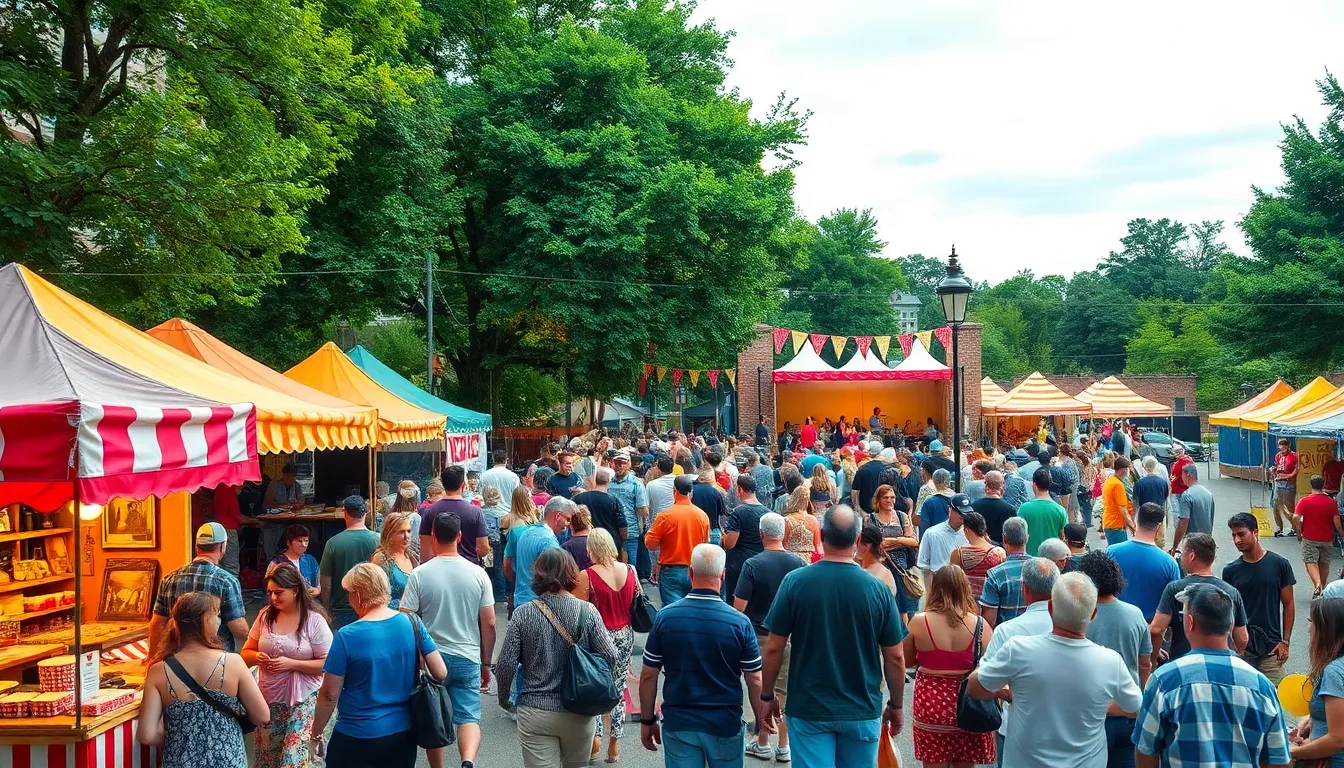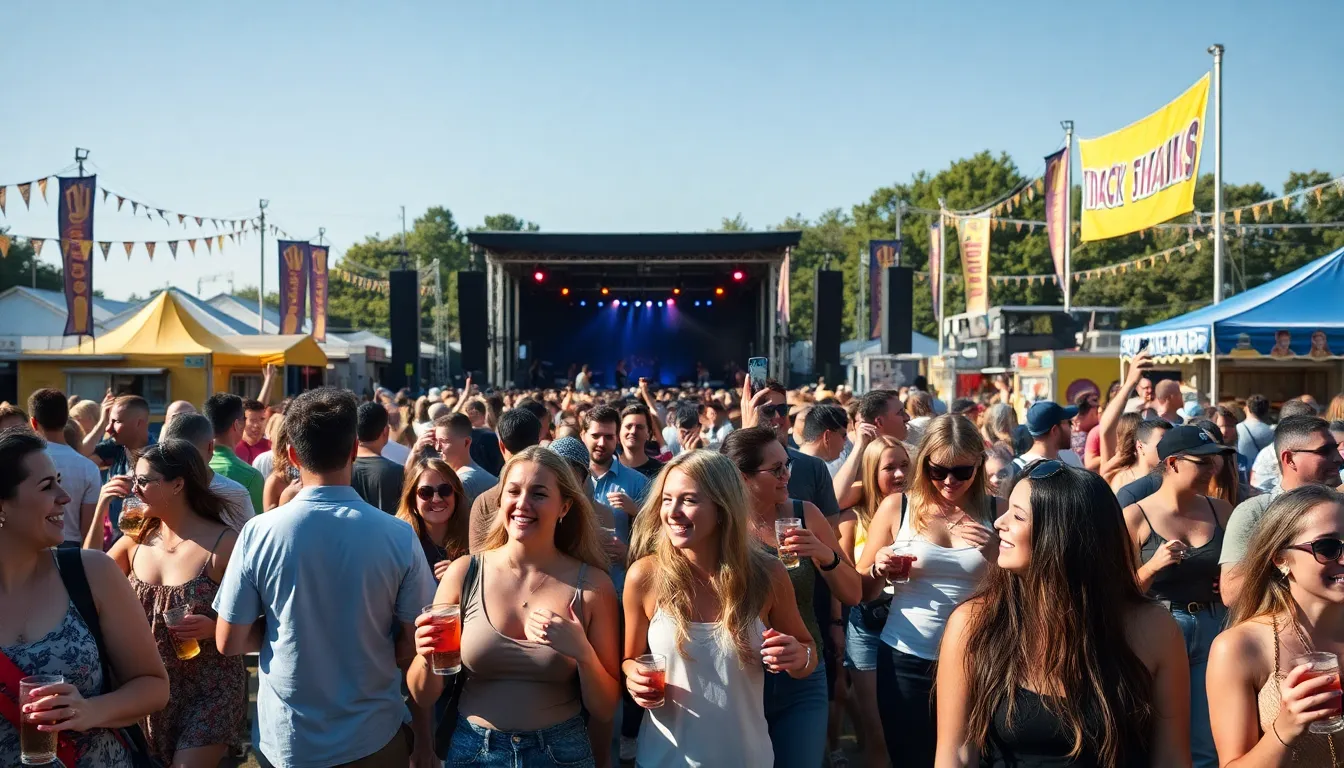Open-air events have become a vibrant part of community life, offering a unique blend of entertainment and connection with nature. From music festivals to outdoor markets, these gatherings invite people to step outside their everyday routines and immerse themselves in a lively atmosphere. The appeal lies not just in the activities but also in the shared experiences that foster a sense of belonging.
As cities and towns embrace the charm of open-air events, they create opportunities for local businesses and artists to shine. These events often showcase regional talent and culture, turning parks and streets into lively hubs of creativity. Whether it’s enjoying live music under the stars or sampling delicious food from local vendors, open-air events provide memorable experiences that resonate long after the last note fades.
Table of Contents
ToggleOverview of Open-Air Events
Open-air events encompass a diverse range of activities held in outdoor settings, promoting social interaction and cultural exchange. These gatherings include music festivals, farmers’ markets, art exhibitions, and sporting events. Each event type contributes uniquely to community engagement and economic growth.
Benefits for Communities
Open-air events stimulate local economies by drawing visitors who contribute to sales in nearby shops and restaurants. They create vibrant public spaces that foster connections among community members. Moreover, they enhance access to cultural experiences and promote regional artists and artisans.
Types of Open-Air Events
- Music Festivals: These events feature regional and national artists, attracting large audiences and showcasing local talent.
- Farmers’ Markets: These markets provide fresh produce and handmade goods, supporting local agriculture and small businesses.
- Art Exhibitions: Outdoor installations allow artists to reach wider audiences, enriching community art scenes.
- Sporting Events: Local sports competitions engage the community, encouraging participation and team spirit.
Seasonal Influence on Open-Air Events
Open-air events often occur during warmer months, capitalizing on favorable weather. However, some events adapt to different seasons by incorporating seasonal themes, such as winter markets or summer fairs. Each season influences attendance, vendor participation, and event planning.
Conclusion of Open-Air Events
Open-air events serve as essential components of community life. They offer opportunities for engagement, cultural expression, and economic stimulation. As communities continue to embrace these gatherings, they reinforce a sense of belonging and support among residents.
Types of Open-Air Events

Open-air events encompass a variety of gatherings that foster community interactions and cultural experiences. Below are some prominent types of these events.
Festivals
Festivals celebrate cultural, artistic, or seasonal themes, drawing large crowds. Typically held in parks or public spaces, festivals feature food vendors, local artisans, and live entertainment, enhancing community spirit. Examples include food festivals, film festivals, and cultural heritage festivals, each showcasing unique traditions and fostering appreciation for diverse backgrounds.
Concerts
Concerts bring together music lovers in a lively outdoor setting. Open-air concerts vary in genre, ranging from rock and jazz to classical and folk. They often take place in local amphitheaters or parks and include performances by emerging and established artists. These events not only entertain attendees but also promote local talent and stimulate business for nearby food and beverage vendors.
Markets
Markets offer a platform for local vendors to showcase their products and connect with the community. Open-air markets, such as farmers’ markets and artisan markets, typically feature fresh produce, handmade goods, and unique crafts. These gatherings support small businesses and encourage residents to shop locally while enjoying a dynamic and vibrant atmosphere.
Benefits of Open-Air Events
Open-air events provide significant advantages for individuals and communities alike. They enhance community engagement and stimulate economic growth.
Community Engagement
Community engagement flourishes through open-air events. Festivals, markets, and concerts draw diverse crowds, fostering connections among residents. People of different backgrounds come together, sharing experiences and creating memories. These gatherings promote social interaction, allowing attendees to form new friendships and strengthen existing relationships. Furthermore, local organizations often participate, enabling residents to support various causes while enjoying entertainment and activities.
Economic Impact
Economic impact emerges as a crucial benefit of open-air events. These events attract visitors, increasing foot traffic to local businesses, such as shops and restaurants. Local vendors often showcase their products, boosting sales and visibility. In some cases, open-air events generate revenue for municipalities through permits and sponsorships. Research indicates that events like farmers’ markets and art fairs can enhance spending in surrounding areas by up to 40%. By investing in local talent and creating opportunities for employment, open-air events play an integral role in regional economic development.
Challenges in Organizing Open-Air Events
Organizing open-air events presents unique challenges that event planners must navigate to ensure successful gatherings. Weather considerations and logistics impact both execution and attendee experience.
Weather Considerations
Weather poses a significant challenge for open-air events, as conditions can change rapidly. Rain, high winds, or extreme temperatures can lead to safety concerns and reduced attendance. For instance, events held during the summer may face unexpected thunderstorms, necessitating contingency plans. Proper forecasts should be monitored closely, and organizers may need to develop alternative arrangements, such as tents or indoor venues, to mitigate potential disruptions. Additionally, clear communication with attendees regarding any changes is vital for maintaining trust and attendance.
Logistics and Safety
Logistical planning is essential for the success of open-air events, encompassing aspects such as site selection, equipment rental, and crowd management. Organizers must assess venue suitability, considering accessibility and capacity. Coordinating vendors and service providers also requires careful scheduling to avoid overlaps. Safety measures must be prioritized, including appropriate crowd control protocols, emergency response plans, and compliance with local regulations. Regular safety inspections and adequate medical support can address potential hazards and enhance overall attendee safety.
Popular Open-Air Events Around the World
Open-air events attract diverse audiences worldwide, showcasing community culture and fostering engagement. Here are some notable examples:
Music Festivals
- Glastonbury Festival, UK: Features over 3,000 performances across various stages, drawing around 200,000 attendees each year. Celebrated for its eclectic lineup, it supports emerging artists.
- Coachella Valley Music and Arts Festival, USA: Hosts around 250,000 attendees over two weekends, highlighting popular music genres and modern art installations.
- Tomorrowland, Belgium: This electronic dance music festival attracts more than 400,000 visitors annually, celebrated for immersive stage designs and a vibrant atmosphere.
Food Festivals
- Oktoberfest, Germany: This iconic beer festival welcomes about 6 million visitors, featuring traditional German cuisine and cultural events, significantly boosting the local economy.
- Taste of Chicago, USA: Showcases the city’s culinary diversity, attracting roughly 1.5 million attendees each summer, offering a taste of local restaurants and food vendors.
Cultural and Art Festivals
- Edinburgh Festival Fringe, Scotland: Known as the largest arts festival globally, it features more than 50,000 performances from thousands of artists across diverse genres, attracting around 2 million visitors.
- Burning Man, USA: This temporary city hosts around 70,000 participants each year, focusing on community and artistic expression in a unique desert environment.
Sporting Events
- The Rose Bowl, USA: An annual college football game that attracts over 90,000 spectators, celebrated for its rich history and New Year’s Day tradition.
- Tour de France: This world-renowned cycling race covers over 2,000 miles, attracting millions of fans along the route in stunning outdoor settings.
Outdoor Markets
- Pike Place Market, USA: This historic market in Seattle welcomes over 10 million visitors each year, featuring fresh produce and artisan goods, significantly stimulating the local economy.
- Nishiki Market, Japan: Spanning five blocks, this food market attracts locals and tourists, showcasing Kyoto’s culinary traditions with hundreds of shops and stalls.
These events exemplify the vibrant spirit of open-air gatherings while contributing to community engagement and economic vitality. They attract locals and visitors alike, showcasing diverse cultures and fostering memorable experiences.
Open-air events play a crucial role in enriching community life and fostering connections among residents. They provide unique opportunities for entertainment and cultural expression while supporting local economies and artists. The vibrant atmosphere of these gatherings encourages social interaction and strengthens relationships within neighborhoods.
Despite the challenges event planners face, the benefits of open-air events far outweigh the obstacles. By transforming public spaces into lively hubs of creativity, these events leave lasting impressions on attendees. As communities continue to embrace outdoor gatherings, they’ll undoubtedly discover new ways to celebrate culture and connection, making open-air events an integral part of their social fabric.







